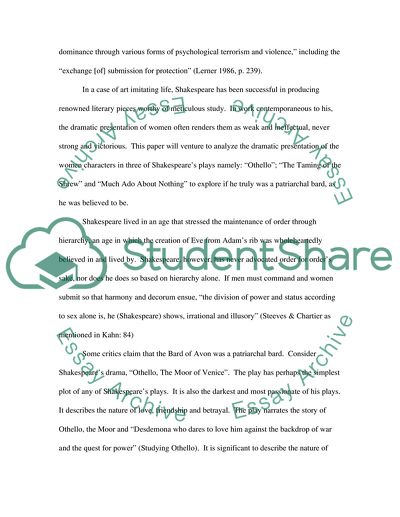Cite this document
(“How Are Women Portrayed in the Dramas of Shakespeare Coursework”, n.d.)
How Are Women Portrayed in the Dramas of Shakespeare Coursework. Retrieved from https://studentshare.org/literature/1744667-the-dramatic-presentation-of-women-renders-them-as-weak-and-ineffective-ultimately-never-strong-and-triumphant-explore-the-dramatic-presentation-of-women-and-assess-how-far-women-in-the-plays-influence-the-dramatic-outcome-and-effect
How Are Women Portrayed in the Dramas of Shakespeare Coursework. Retrieved from https://studentshare.org/literature/1744667-the-dramatic-presentation-of-women-renders-them-as-weak-and-ineffective-ultimately-never-strong-and-triumphant-explore-the-dramatic-presentation-of-women-and-assess-how-far-women-in-the-plays-influence-the-dramatic-outcome-and-effect
(How Are Women Portrayed in the Dramas of Shakespeare Coursework)
How Are Women Portrayed in the Dramas of Shakespeare Coursework. https://studentshare.org/literature/1744667-the-dramatic-presentation-of-women-renders-them-as-weak-and-ineffective-ultimately-never-strong-and-triumphant-explore-the-dramatic-presentation-of-women-and-assess-how-far-women-in-the-plays-influence-the-dramatic-outcome-and-effect.
How Are Women Portrayed in the Dramas of Shakespeare Coursework. https://studentshare.org/literature/1744667-the-dramatic-presentation-of-women-renders-them-as-weak-and-ineffective-ultimately-never-strong-and-triumphant-explore-the-dramatic-presentation-of-women-and-assess-how-far-women-in-the-plays-influence-the-dramatic-outcome-and-effect.
“How Are Women Portrayed in the Dramas of Shakespeare Coursework”, n.d. https://studentshare.org/literature/1744667-the-dramatic-presentation-of-women-renders-them-as-weak-and-ineffective-ultimately-never-strong-and-triumphant-explore-the-dramatic-presentation-of-women-and-assess-how-far-women-in-the-plays-influence-the-dramatic-outcome-and-effect.


